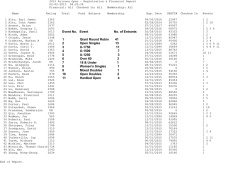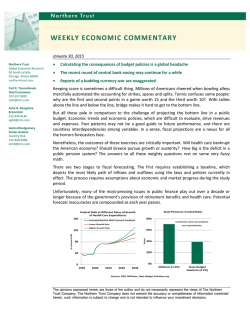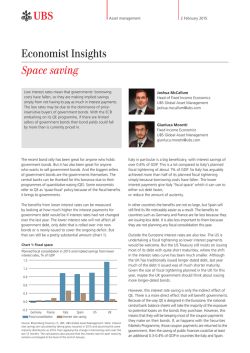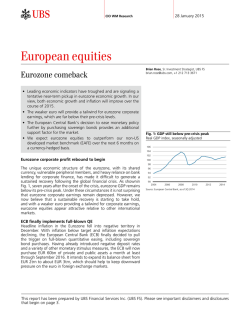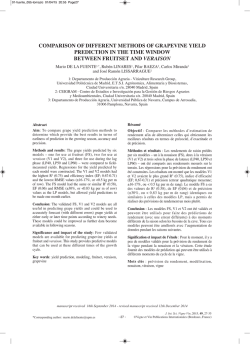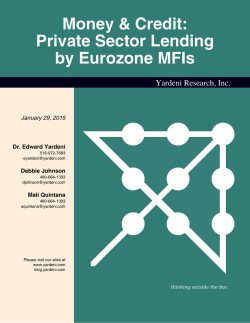
Negative Creep- the Global Economy
NEGATIVE CREEP: THE GLOBAL ECONOMY © Leo Haviland, 646-295-8385 February 2, 2015 Nirvana sings in “Negative Creep”: “This is out of our reach and it’s grown…This is getting to be a drone…” **** OVERVIEW AND CONCLUSION The European Central Bank’s magnificent march into full-scale quantitative easing captivates cheerleaders hoping for significant European (and worldwide) economic growth, a decisive defeat of the evil deflationary dragon, and further bullish ascents in stock marketplaces such as the S+P 500. Prior massive money printing, especially but not only by the Federal Reserve, engendered optimism, enhanced near-term economic growth, and helped to propel many equity benchmarks (notably the S+P 500) upward. So given the ECB’s bold policy announcement on 1/22/15, shouldn’t we all be rather positive about global (and Eurozone) economic prospects? No. Of course the ECB’s decision to begin devouring “euro-denominated investment-grade securities issued by euro area governments and agencies and European institutions in the secondary market” is only one variable. But despite that central bank’s long-hoped for purchasing scheme, adequate Eurozone GDP growth still appears out of reach, and overall international economic prospects look less robust than they seemed only a few months ago. In addition, despite the ECB’s dramatic policy intervention, key government securities yields show little signs of climbing. This holds true not merely for Germany, but also the United States and Japan. Plus the broad real tradeweighted United States dollar remains relatively strong, nearing critical points achieved in mid2008 during the global financial disaster. After their massive tumble in recent months, commodities in general (use the broad Goldman Sachs Commodity Index as a benchmark) remain well beneath their June 2014 (and previous) heights. Yet at least shouldn’t the ECB’s big easing at least manage to rally key stock arenas, and especially to push the S+P 500 above its December 2014 summit? Recall what happened to the S+P 500 after the Federal Reserve unveiled its quantitative easing rounds, or what occurred after Japan introduced “Abenomics” and Quantitative and Qualitative Easing! However, the S+P 500’s inability thus far to creep up to new bull trend highs beyond its 12/29/14 summit at 2094 contrasts with its prior behavior after the Fed’s QE programs. Again, keep in mind recent yield patterns of key government yield signposts such as the US and German 10 year notes, as well as the stronger dollar and weaker commodities. Also, emerging stock marketplaces in general, with various twists and turns, gradually have sagged lower since their spring 2011 high. So although admittedly not much time has passed since the ECB’s December action, these interrelated factors and slipping world growth prospects indicate that the ECB’s new policy probably will not produce the hoped-for rally in the S+P 500 and related stock playgrounds. These present-day marketplace variables, especially when interpreted alongside their history during the mournful 2007-09 global economic crisis, instead suggest that a notable S+P 500 downtrend is or soon will be underway. And in today’s environment, what happens to American stocks if overall US corporate earnings slow or move into reverse? **** For additional fundamental and technical information and analysis related to these interrelated marketplace issues and trends, see essays such as “Do What We Must: Eurozone Theatrics” (1/3/15), “Marketplace Entanglements: Revisiting 2008” (12/14/14), “Whatever It Takes: Recent Eurozone and Japanese Adventures” (12/1/14), “Currency Contexts: Recent Rallies in the Dollar and Renminbi” (11/9/14), “Talking the Talk: Marketplace Parallels” (10/19/14), “Walking the Walk: US Stocks and the Dollar” (10/5/14), “Stepping Higher: UST Two Year Note Yields” (9/21/14), “Bond Yield Perspectives: Easing Comes, Easing Goes” (9/1/14), “Commodity Marketplace Travels” (8/1/14), and “Exit Strategies: The Fed, US Treasuries, and US Stocks” (7/14/14). SLOWING DOWN “God only knows, God makes his plan The information’s unavailable to the mortal man We’re workin’ our jobs, collect our pay Believe we’re gliding down the highway, when in fact we’re slip sliding away”. Simon and Garfunkle, “Slip Slidin’ Away” **** According to the International Monetary Fund’s recently released “World Economic Outlook Update” (1/19/15; Table 1), 2014’s 3.3 percent global real GDP growth rate snakes up slightly faster, to 3.5pc in 2015 and 3.7pc in 2016. Many observers will put a positive spin on these small increases of 2015 and 2016 relative to 2014. Yet significantly, the IMF cut its global real GDP estimates for 2015 and 2016. Its prediction revises both 2015 and 2016 forecasts downward by .3 percent relative to its October 2014 projection. Even though the IMF’s January 2015 output numbers for advanced economies remained essentially unchanged (up 2.4pc) for both 2015 and 2016, it slashed its prior projections for emerging market and developing economies by .6pc for 2015 and .5pc for 2016. Notably, China’s remarkable GDP growth rate continues to ebb. It stood at 7.8pc in 2013. However, it was 7.4pc in 2014, and the IMF expects 2015’s will edge down to 6.8pc, with 2016’s at 6.3pc. Although global growth receives a boost from the precipitous fall in petroleum prices, the IMF prophet states “this boost is projected to be more than offset by negative factors”. **** Isn’t America supposed to be a growth engine for the world economy? Although clairvoyants of course need not agree, arguably even the IMF’s current growth predictions are too optimistic. For a partial picture, compare the IMF’s GDP levels for the United States with those of the Federal Reserve. The IMF indicates 2014 US year-on-year growth at 2.4pc. This fits the Fed’s 2.4pc view (see its Economic Projections, midpoint of central tendency; 12/17/14) and the just-released official statistic of 2.4pc (Bureau of Economic Analysis, 1/30/15). The January 2015 WEO update declares US 2015 growth climbs to 3.6pc, with 2016’s 3.3pc. The Fed’s Economic Projections for real GDP (midpoint of central tendency) are much less, at only 2.8pc for both 2015 and 2016. In addition, the Fed’s “longer run” real GDP range is 2.0 to 2.3pc. Significantly, United States 4Q14 real GDP increased at a 2.6pc annual rate, down sharply from 3Q14’s 5.0pc. 2 FALLING GOVERNMENT YIELDS: AMERICA, GERMANY, AND JAPAN The Bush Tetras complain in their song “Too Many Creeps”: “I just can’t pay the price Of shopping around No more Because there’s just nothing That’s worth the cost It’s the worst” **** As deflation (and insufficient inflation) fears have blossomed over the past year, yields for key government note benchmarks of flight to quality (safe haven) nations such as the United States, Germany, and Japan have slipped steadily lower. This sustained pattern of lower yields represents an ominous bearish sign for the world economy. For example, the 10 year US Treasury note yield made a high at 3.05 percent just over a year ago, on 1/2/14. Although thereafter the US ended (“tapered”) its quantitative easing program, the UST decisively broke under a key floor around 2.40pc and has ventured under 1.70pc. The German 10 year note yielded 2.09pc on 9/11/13 and 1.96pc on 12/27/13. Its yield has tumbled to under .40pc, beneath crucial support around 1.15pc (note the 7/23/12 low). Japan’s 10 year JGB government note yield established a minor interim high around .75pc in late December 2013. Since then, its yield has slithered down to under .30pc. Especially in the overall Eurozone context, focus on the remarkable phenomenon of negative interest rate yields. Citing JPMorgan’s calculations, the Financial Times underscores its growth (1/29/15, p7): “The pace at which the ‘negative universe’ has expanded is striking.” About €1.5 trillion in Eurozone government bonds with a maturity over one year (almost a quarter of the total) yield less than zero. The FT also points to negative yields on Swiss and Japanese bonds. **** The IMF’s World Economic Outlook predicts 2015 consumer prices in advanced economies will inch up only 1.0pc, rising slightly to a 1.5pc clip in 2016. The Federal Reserve forecasts PCE inflation of only 1.3pc for 2015, well below the Fed’s two percent inflation objective. The Federal Funds level remains pinned near the ground. If the US economy is genuinely robust, why does the Fed still not allow the Federal Funds rate to creep up? Eurostat (1/30/15) expects the Euro Area’s January 2015 year-on-year inflation will be -.6 percent (actual deflation; driven by the slump in energy prices). December 2014 inflation was -.2pc. Even excluding energy, January 2015 inflation was up a paltry .4pc. **** Even while yields on government debt of nations such as America and Germany decline, yields on debt securities of lower quality issuers, whether sovereign or corporate, can rise or even soar. Slower economic growth tends to burden substantial debtors. Given the Eurozone’s deflation worries and the ECB’s shift to money printing, keep an eye on Greece. During the European periphery crisis, and especially given it recent switch to a more confrontational and left-wing government, Greece has inspired much worry. See several recent newspaper headlines: “Eurozone fears Greece’s bailout attitude will lead to chaos” (Financial Times, 2/2/15, p2); “For Greece, Bank Trouble Looms Again as New Government Takes Shape” 3 (NYTimes, 2/2/15, pB3); “Greece takes defiant stance with creditors” (FT, 1/31-2/1/15, p2); “Fears mount over Greek plans to roll back reforms” (FT, 1/30/15, p3); “Berlin and Paris rebuff debt forgiveness call” (1/29/15, p2); ”Greece and global creditors dig in for fresh struggle over austerity” (FT, 1/27/15, p1); “Greek leftist’s victory throws down challenge to euro establishment” (FT, 1/26/15 p1). The “Size of Greek debt mountain limits scope for solutions” (Financial Times, 1/14/15, p4). Although Greece’s debt troubles are gigantic, it is not the only nation facing debt difficulties. And a list of such countries does not end with emerging/developing marketplaces. Note Japan’s mountainous government debt. Even America faces long run deficit challenges. **** Although it depends on particular circumstances, a stronger US dollar can magnify the burdens of many borrowers required to repay substantial sums of dollar-denominated debt. THE DOLLAR’S CLIMB: POSITIVE CREEP In recent months, the broad real trade-weighted dollar (“TWD”) has climbed steadily. After its major low around 80.5 in July 2011 (Federal Reserve, H.10; monthly average), it moved sideways in serpentine fashion over a narrow range for roughly the next three years, with its high over that span June 2012’s 86.3. September 2014’s 86.6 broke through this barrier, with December 2014’s attaining 90.8. The nominal broad real trade-weighted dollar average for January 2015 (based upon daily data; as of 2/1/15, daily data available ran through 1/23/15) has climbed about 1.7 percent relative to its December 2014 average. Assuming a similar ascent in the broad real TWD, January 2015’s broad real TWD probably is about 92.4. This recent strengthening of the broad real TWD signals weakness for the overall US stock marketplace. Recall the acceleration of the worldwide economic crisis (and decline in the S+P 500) in 2008 as the broad real TWD appreciated. The S+P 500’s major peak occurred 10/11/07 at 1576, but its final high was 5/19/08 at 1440. After establishing a major low at 84.2 in April 2008, the broad real TWD rallied to 86.7 in August 2008 and 88.8 in September 2008; it then jumped to over 93.8 in October 2008 (current levels thus border on this), attaining a final high in March 2009 around 96.9. The S+P 500 collapsed from around 1313 (8/18/08)/1265 (9/19/08). The S+P 500’s major bottom at 667 on 3/6/09 occurred the same month as the broad real TWD pinnacle. A five percent bull move in the TWD from its July 2011 trough at 80.5 equals about 84.5, a ten percent climb about 88.6. A fifteen pc rally gives 92.6, a 20pc leap about 96.6. US STOCKS: STARTING TO CRAWL DOWNHILL “In the United States today, we have more than our share of nattering nabobs of negativism. They have formed their own 4-H Club- the hopeless, hysterical, hypochondriacs of history.” Speech 9/11/70 by US Vice President (under President Richard Nixon) Spiro Agnew at the California Republican state convention in San Diego (William Safire, speechwriter) **** 4 If there can be excessive negativity in economics, politics, or elsewhere in culture, presumably excessive positivity can reign. In financial marketplaces, recall wordplay such as “irrational exuberance”. Has the Federal Reserve’s long-lasting easy money policy (assisted by other central banks and by American and other deficit spending) abolished bear marketplaces in US stock benchmarks such as the S+P 500? Widespread faith- encouraged by Wall Street rhetoric- in the probability of profitability of US stock “investment” (at least over the misty long run) helps to underpin optimism in regard to US stocks. The long duration of the monumental rally in the S+P 500 (3/6/09 major bottom at 667) to some extent bolsters confidence that the bull trend will continue. For the S+P 500 nowadays, in addition to considering interest rate, currency, emerging marketplace stock, and commodity trends, note the potential for slowing (or falling) United States corporate earnings. The Financial Times (citing S+P Capital IQ), 4Q14 earnings for the S+P 500 currently are expected to grow 4.9 percent year-on-year; however, the earnings forecasts for that period have fallen steadily since July 1 (1/14/15, p1). Look further forward. According to Bloomberg’s recent compilation of analyst estimates, analysts currently expect earnings per share from S+P 500 companies to decline 2.1 percent in 1Q15 and erode 1.1pc in 2Q15. According to Bloomberg, these would be the first consecutive profit slides since 2009 (1/30/15). A five percent fall from the S+P 500’s 12/29/14 height near 2094 is about 1989, a 10pc retreat 1884. A 15pc drop equals about 1780, with a 20pc dive 1675. **** This essay is furnished on an “as is” basis. Leo Haviland does not warrant the accuracy or correctness of this essay or the information contained therein. Leo Haviland makes no warranty, express or implied, as to the use of any information contained in this essay in connection with the trading of equities, interest rates, currencies, or commodities, or for any other use. Leo Haviland makes no express or implied warranties and expressly disclaims all warranties of merchantability or fitness for a particular purpose. In no event shall Leo Haviland be liable for any direct, indirect, special, incidental, or consequential damages (including but not limited to trading losses or lost profits) arising out of or related to the accuracy or correctness of this essay or the information contained therein, whether based on contract, warranty, tort, or any other legal theory. All content copyright © 2015 Leo Haviland. All Rights Reserved. 5
© Copyright 2026
